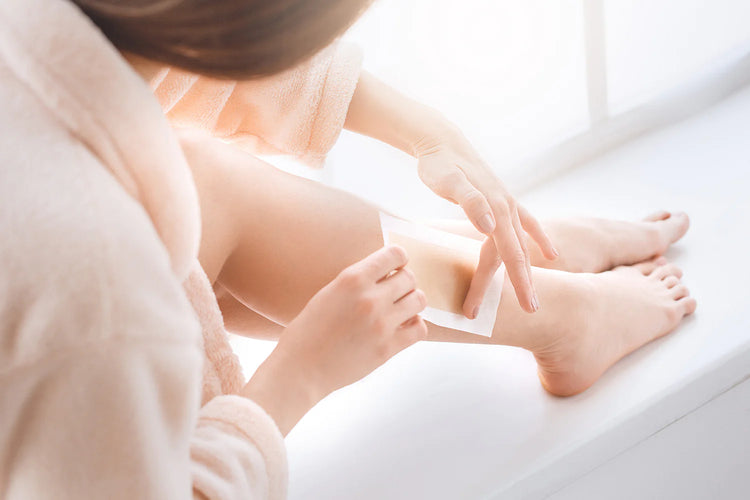With the rise of DIY beauty treatments, many people are opting to skip the salon and try their hand at waxing. While it's certainly possible to safely wax at home, it's important to take the proper precautions. After all, the last thing you want is to end up with irritated skin or an infection.
The answer is yes, but only if you do it right. It's crucial to use the right products, prep your skin properly, and follow all of the necessary steps to minimize the risk of injury or damage.
In this post, we'll delve into the details of how to safely and effectively wax at home. From choosing the right kind of wax to tips for post-wax care, we've got you covered. So grab your waxing kit and let's get started.
Is It Safe To Wax Yourself At Home: 7 Precautions & Safety Measures

Waxing is a popular hair removal method used at home or by a professional. While at-home waxing may save you money and convenience, risks are involved. Before you wax at home, be sure to follow these precautions:
Familiarize Yourself with The Process:
If you are familiar with waxing, you can do it at home safely. Without experience and knowledge, mistakes such as improper wax application or removal can lead to skin irritation or injury. Research the waxing process, including the type of wax suitable for your skin, the application method, and the proper way to remove it.
Conduct a Skin Patch Test:
Ensure the wax works well on your skin by conducting a patch test before waxing. An allergy test involves applying wax to a small area of skin and waiting 24 hours to see if there are any reactions. If there is no adverse reaction, proceeding with the waxing process is safe.
Check Your Skin Type:

Determining your skin type is crucial as it helps determine the type of wax to use and how it may affect your skin. You should avoid waxing if your skin is sensitive since it can aggravate and irritate skin sensitivity. Also, waxing can irritate the areas affected by skin conditions such as eczema and psoriasis.
Clean Your Skin Thoroughly:
Before waxing, you should thoroughly clean your skin to remove oils, dirt, dead skin cells, and skin care products that could interfere with the wax's effectiveness. Using soap or body wash is recommended, but alcohol-containing products should be avoided since they may dry out the skin and irritate it.
Use The Right Products:
The right products are essential for a safe and successful waxing experience. Use wax designed for your skin type and desired hair removal area. Also, ensure you use a high-quality waxing kit with the necessary tools, such as spatulas and strips.
Control The Temperature:

Keeping the wax at a suitable temperature is vital to avoid burning or scalding the skin. Following the wax manufacturer's instructions when heating and cooling the wax is important to prevent accidents.
Avoid Double-Dipping:
Double-dipping is using the same wax application tool twice. This is not recommended as it may introduce bacteria, dead cells, and other unwanted elements into the wax, leading to skin infections and irritation. Use a new wax application tool for each application to avoid contamination and cross-infection of the skin.

Be Gentle With Your Skin:
It is crucial to be gentle with your skin during waxing. Do not apply too much pressure or pull the skin too hard when removing the wax. Aggressive pulling may cause skin irritation, inflammation, and even bruising. Be gentle with your skin to avoid injury or discomfort.
Take the necessary precautions and follow the right procedure to wax yourself at home. Waxing may not be appropriate for everyone, and certain skin conditions may react negatively to the procedure.
4 Risks Of Waxing Yourself At Home
The primary risk associated with at-home waxing is the potential for burns, cuts, and skin irritations. This may be due to using too hot wax or applying it too forcefully or too often. Some of the risks involved in waxing yourself at home include:
Skin Burns And Blisters:

Waxing yourself at home can risk skin burns and blisters if the wax is overheated or applied too hot. It may take a long time for sensitive skin to heal fully from burns and blisters caused by improperly heated resin.
Some waxing kits come with flimsy instructions that may not provide adequate guidance on using the wax safely. Waxing yourself at home is not entirely safe, as the likelihood of skin burns and blisters is high.
Skin Irritation:
Skin irritation is another potential risk of waxing yourself at home. The skin may become red, swollen, and itchy after waxing due to multiple reasons, such as sensitive skin types, allergies, or the quality of the wax itself.
Using inappropriate waxing techniques numerous times in the same area can strip the skin of its natural protective barrier, leading to skin irritation. A patch test and choosing high-quality wax and waxing kits are essential for waxing at home.
Allergic Reactions:
Waxing yourself at home can cause allergic reactions if the waxing kit contains harsh chemicals that your skin cannot handle. A severe reaction, such as anaphylactic shock, can result from the chemicals.
It is essential to read the ingredients list thoroughly before waxing. Also, suppose you have sensitive skin or a history of allergic reactions. When waxing yourself at home, it is always best to consult a dermatologist or experienced professional.

Improper Hair Removal:
Waxing oneself at home can lead to improper removal that can cause ingrown hairs, broken hair follicles, and patchy hair growth. Maintaining the right temperature and applying the wax correctly will prevent any mishaps.
Too long hair can also break at the skin's surface, resulting in uneven growth or ingrown hairs. Before waxing, hair should be trimmed appropriately to avoid complications.
Home waxing poses multiple risks, including skin burns, skin irritation, allergic reactions, improper hair removal, and skin infections. A licensed dermatologist or experienced waxing professional is recommended if you want a successful and safe waxing experience.
How To Minimize Waxing: 4 Risks And Challenges
Waxing is an effective way to remove unwanted hair, but it can be risky if not performed correctly. Waxing poses several risks and challenges, especially when done at home. Here are some tips to help you stay safe and have a successful at-home waxing experience.
Be Cautious In Temperature Control
When it comes to waxing yourself at home, temperature control is crucial. Be particularly cautious with hot wax, as it can easily burn your skin if it's too hot. Use wax according to the instructions on the packaging, and test it on a small patch of skin before using it more widely.
Keep Skin Dry And Clean

Before waxing yourself at home, ensure your skin is clean and dry. When moisture is present, wax can adhere less effectively and cause skin irritation. Keeping your skin dry and clean can prevent infections caused by bacteria.
Seek Professional Assistance, If Required
If you're unsure how to wax yourself at home, have sensitive skin, or have a history of skin conditions, it's best to seek professional assistance. You can minimize injuries and infection risks with the help of a trained esthetician who understands your skin and wax types.
Regularly Check Your Skin To Avoid Infections
After waxing yourself at home, regularly check your skin for signs of infection. Look out for redness, swelling, tenderness, or pus, indicating that bacteria has entered the hair follicles. If you notice any of these symptoms, seek medical attention immediately.
Conclusion
Waxing yourself at home can be safe and effective if you take the necessary precautions. As well as seeking professional help and checking regularly for signs of infection, keep your skin dry and clean.
Follow these guidelines to enjoy smooth, hair-free skin without exposing yourself to unnecessary risks.

